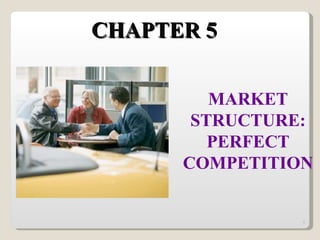
MKT5-Perfect Competition
- 1. CHAPTER 5 MARKET STRUCTURE: PERFECT COMPETITION
- 6. Firm Industry 100 Figure: Market Equilibrium and Firm’s Demand Curve Price taker d $4 Output (bushels) Price $ per bushel D $4 S Price $ per bushel Output (millions of bushels)
- 12. Total Revenue, Average Revenue and Marginal Revenue for a competitive firm Quantity sold Price (RM) TR (RM) AR (RM) MR (RM) 0 20 0 20 20 1 20 20 20 20 2 20 40 20 20 3 20 60 20 20 4 20 80 20 20 5 20 100 20 20 6 20 120 20 20 7 20 140 20 20 8 20 160 20 20
- 13. Graphical Illustration of TR, AR and MR for a Competitive Firm TR AR = MR=D 1 2 3 4 5 6 7 8 9 10 160 140 120 100 80 60 40 20 0 Price and revenue Quantity Demanded (sold)
- 14. Profit maximization – Numerical example Quantity TR (RM) TC (RM) PROFIT (RM) MR (RM) MC (RM) 0 0 10 -10 - - 1 20 14 6 20 4 2 40 22 18 20 8 3 60 34 26 20 12 4 80 50 30 20 16 5 100 70 30 20 20 6 120 94 26 20 24 7 140 122 18 20 28 8 160 154 6 20 32
- 15. 160 140 120 100 80 60 40 20 0 Total revenue and total cost Total Revenue Total Cost Maximum Economic Profits RM30 Break-Even Point (Normal Profit) Break-Even Point (Normal Profit) 1 2 3 4 5 6 7 8 1. TOTAL REVENUE-TOTAL COST APPROACH
- 17. 2. MARGINAL REVENUE- MARGINAL COST APPROACH A q 1 : MR > MC; ↑ output q 2 : MR < MC; ↓ output q * : MR = MC Profit is maximized where MR = MC Profit increases until it is maxed at q* q 2 10 20 30 40 Price 50 MC 0 1 2 3 4 5 6 7 8 9 10 11 Output q * AR=MR=P q 1 Lost Profit for q 2 > q* Lost Profit for q 1 < q*
- 22. Cost and Revenue 1 2 3 4 5 6 7 8 9 10 MC MR=AR=P ATC Economic Profit RM5 RM3 Supernormal Profit/ Economic Profit Minimum point of ATC
- 24. Cost and Revenue 1 2 3 4 5 6 7 8 9 10 MC MR=AR ATC RM5 Breakeven/ Normal Profit Minimum point of ATC
- 26. Cost and Revenue 1 2 3 4 5 6 7 8 9 10 MC MR=AR ATC Economic Loss RM5 RM7 Economic losses/ Subnormal profit
- 28. Cost and Revenue 1 2 3 4 5 6 7 8 9 10 MC MR=AR AVC ATC Economic Loss P ATC Subnormal Profit (ATC>P>AVC)): (i) Keep Operating AVC
- 29. Cost and Revenue 1 2 3 4 5 6 7 8 9 10 MC MR=AR AVC ATC Economic Loss P ATC Subnormal Profits (ATC>P<AVC): (ii) Shutdown AVC
- 33. Cost and Revenue, (dollars) MC AVC ATC Quantity Supplied P 1 P 2 P 3 P 4 P 5 Q 2 Q 3 Q 4 Q 5 Marginal Cost & Short-Run Supply Do not Produce Below AVC(< P 2 ) Normal Profit Shut down point Subnormal profit Supernormal profit
- 34. Cost and Revenue, (dollars) MR 1 Quantity Supplied MR 2 MR 3 MR 4 MR 5 P 1 P 2 P 3 P 4 P 5 Q 2 Q 3 Q 4 Q 5 Marginal Cost & Short-Run Supply Short-Run Supply Curve Supply No Production Below AVC
- 38. Try this!!
- 40. Try this!!
- 42. (1) Changing Preference Increase in demand Firm Industry
- 44. S 1 MC ATC MR D 1 Before Increase in Demand P Q q1 P Q Q1 Industry Firm (price taker) P1 P1
- 45. DD increases – DD curve shift left – P ↑ - Q ↑ - supernormal profit – new firms enter MR D 1 MC ATC D 2 Economic Profits S 1 MR 1 P Q q1 q2 P Q Q1 Q2 Industry Firm (price taker) P2 P1 P2 P1
- 46. New entry – SS ↑ - Q↑ - P↓ - (P = ATC) normal profit MR D 1 MC ATC D 2 Zero Economic Profits S 1 S 2 q2 Q1Q2Q3 IMPORTANT!! P Q q1 P Q Industry Firm (price taker) P2 P1 P2 P1
- 47. Changing Preference : Decrease in demand Industry Firm
- 49. Before decrease in demand: S 1 MC ATC D 1 MR P Q q1 P Q Q1 Industry Firm (price taker) P1 P1
- 50. MR D 1 MC ATC D 2 Economic Losses S 1 q2 DD decreases – DD curve shift right – P ↓ - Q ↓ - subnormal profit – existing firms exit P Q q1 P Q Q2Q1 Industry Firm (price taker) P1 P2 P1 P2
- 51. MR D 1 MC ATC D 2 Zero Economic Profits S 1 S 3 Q3 q2 Existing firms exit – SS ↓ - Q↓ - P↑: (P = ATC) normal profit IMPORTANT!! P Q q1 P Q Q2 Q1 Industry Firm (price taker) $60 50 40 $60 50 40
- 52. (2) Advancing Technology: Technology Improvements (a) Adopt new technology (b) Old technology firm Economic loss Positive economic profit New firms entry SS up, P down Profit reducing Produce at lower cost Exit Adopt new technology SS down, P up Zero economic profit
- 58. LETS DO IT
- 59. Output (unit) Total cost (RM) Variable cost (RM) 1 15 10 2 21 16 3 28 23 4 37 32 5 50 45 6 68 63
- 61. THANK YOU
Editor's Notes
- 5
- 8
- 36
- 28
